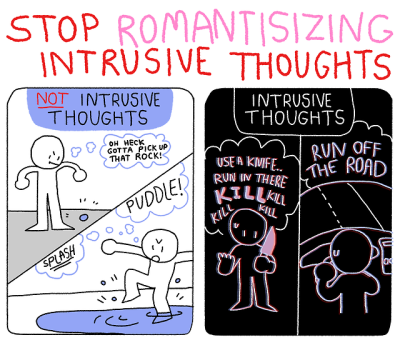
In the first, nonclinical participants are typically provided with a list of UITs and neutralizing behaviors and are asked to indicate which of these UITs and behaviors they have personally experienced. This is mainly for practical reasons (easy to assess and affordable) but there are certain advantages as well. It is common to study obsessive-compulsive (OC) phenomena in samples that do not necessarily include individuals with clinically relevant OC symptoms. Previous studies suggest that the differences between UITs/neutralizing behaviors and obsessions/compulsions are a matter of degree rather than kind: The content is comparable, but UITs and neutralizing behaviors occur less frequently and are less distressing, and UITs interfere less with daily life than obsessions. Additionally, they tend to be followed by overt or covert neutralizing behaviors (termed compulsions in the context of OCD) with the aim of reducing the associated anxiety. Both UITs and obsessions are by definition repetitive intrusive thoughts, images, or impulses that are unwanted and disruptive. The cognitive model of obsessive-compulsive disorder (OCD) postulates that UITs lie on a continuum with obsessions, since UITs share certain commonalities with clinically relevant obsessions. Previous studies have demonstrated that UITs are ubiquitous and occur irrespective of cultural differences. Such unwanted intrusive thoughts (UITs) occur on a variety of themes such as contamination fears, doubts about possible mistakes, harm, immoral sexual thoughts, religion, and symmetry or order. Ĭompeting interests: The authors have declared that no competing interests exist.Īlmost everyone occasionally experiences thoughts that enter the mind abruptly and are perceived as unwanted. The SNSF was not involved in study design, data collection and analysis, decision to publish, or preparation of the manuscript.

The Swiss National Science Foundation (SNSF) is funding the PhD position for Martin Kollárik and Carlotta V. Please note we did not include the gender variable and the time stamp variables of the ecological momentary assessment prompts due to anonymity.įunding: This research did not receive any specific grant from funding agencies in the public, commercial, or not-for-profit sectors. This is an open access article distributed under the terms of the Creative Commons Attribution License, which permits unrestricted use, distribution, and reproduction in any medium, provided the original author and source are credited.ĭata Availability: The data is accessible via OSF: DOI ( 10.17605/OSF.IO/6JNRY). Received: Accepted: JPublished: July 5, 2022Ĭopyright: © 2022 Kollárik et al. Steinborn, Julius-Maximilians-Universität Würzburg, GERMANY We discuss how research on obsessive-compulsive disorder could benefit from considering exam-related UITs and related behaviors.Ĭitation: Kollárik M, Heinzel CV, Miché M, Lieb R, Wahl K (2022) Exam-related unwanted intrusive thoughts and related neutralizing behaviors: Analogues to obsessions and compulsions. Findings indicate that some aspects of exam-related UITs and related neutralizing behaviors (e.g., association with distress and urge to neutralize) might be analogous to OC symptoms but not all (e.g., no relation to depressed mood). Overall, they were experienced with mild severity, low distress, and low urge to neutralize.

During the study period, the exam-related UITs occurred on average 7 times, and the related neutralizing behaviors on average 6 times. Multilevel analysis demonstrated that the severity of exam-related UITs and related neutralizing behaviors was positively associated with OC symptoms, anxiety, distress, urge to neutralize, and stress but was not related to depressed mood.

Twenty-nine students completed three ecological momentary assessment surveys per day over 7 consecutive days, assessing the severity of exam-related UITs and related neutralizing behaviors, obsessive-compulsive (OC) symptoms, anxiety, distress, urge to neutralize, depressed mood, and stress in the week immediately before an exam period. The present study investigated in what ways these UITs and behaviors are analogues to clinical obsessions and compulsions.

Exam-related unwanted intrusive thoughts (UITs) and related neutralizing behaviors are common experiences among students.


 0 kommentar(er)
0 kommentar(er)
